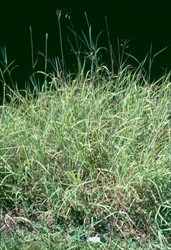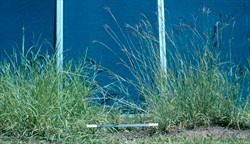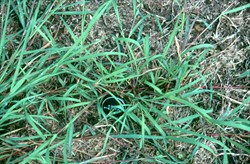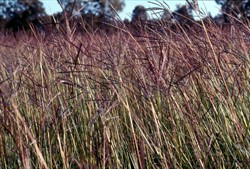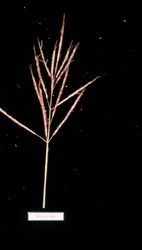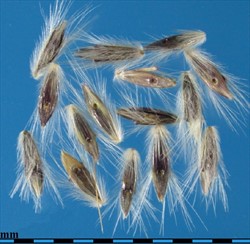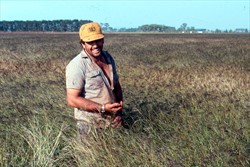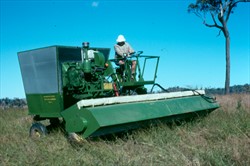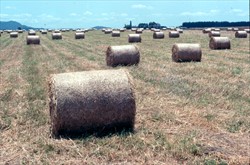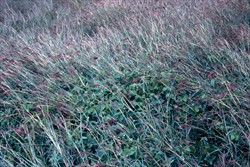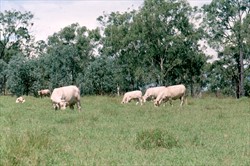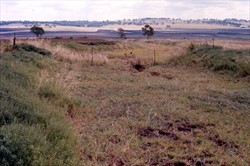Bothriochloa insculpta
Tropical Forages
Bothriochloa insculpta (Hochst. ex A. Rich.) A. Camus
Basionym: Andropogon insculptus Hochst. ex A. Rich.; Andropogon pertusus (L.) Willd. var. insculptus (Hochst. ex A. Rich.) Hack.; Dichanthium insculptum (Hochst. ex A. Rich.) Clayton
Family: Poaceae (alt. Gramineae) subfamily: Panicoideae tribe: Andropogoneae.
A perennial tussock, 30‒80 cm tall (‒1.5 m at maturity); often strongly or weakly stoloniferous; stolons 1.5‒2.5 mm diameter, reddish pink to mauve. Leaves glaucous; leaf blades linear, tapering, to 30 cm long and 8 mm wide, mostly glabrous except for spreading hairs at the base; ligule a fringed membrane, hairs shorter than the membrane. Culm internodes yellow, nodes with annulus of spreading white hairs, to 4 mm long. Inflorescence subdigitate or with a central axis seldom over 3 cm long; 3 to >20 racemes per panicle, 2‒9 cm long, olive green to purplish in colour, lower racemes often branched. Spikelets in pairs, sessile spikelet with single deep pit, and geniculate and twisted awn 15‒25 mm long in the lower glume; pedicellate spikelet glabrous, unawned, usually neuter, with 1‒3 pits in the lower glume. Inflorescence, seed and leaves emit an aromatic odour when crushed. 650,000‒1.2 million seed units/kg (1 seed unit = sessile spikelet + pedicellate spikelet + awn).
Similar species
Bothriochloa insculpta: spreading hairs on the nodes: strongly aromatic inflorescence; pit(s) on the lower glume.
Dichanthium annulatum: spreading hairs on the nodes; little or no aroma in inflorescence; no pit(s) on the lower glume.
Africa: klosgras, lidjiesgras, stinkgras, stippelgras, terpentyn gras, turfklosgras, turfgras (Afrikaans); uhatshi (Ndebele); aus gudun, aus ma’an, domar, gurguro, haldaf, magalhed (Somalia); motsamabudi (Sotho); umKunena (Zimbabwe); imbutane (Zulu)
English: creeping bluegrass, pinhole grass, stippel grass, sweet-pit grass, sweet pitted grass, tassel grass, turf grass
India: hennu ganjalub garikai hullu
Latin America: pasto dulce picado (Spanish)
Native:
Africa: Botswana; Democratic Republic of Congo; Eritrea; Ethiopia; Kenya; Lesotho; Malawi; Morocco; Mozambique; Namibia; Somalia; South Africa (Eastern Cape, Free State, Gauteng, KwaZulu-Natal, Limpopo, Mpumalanga, North West, Northern Cape, Western Cape); Swaziland; Tanzania; Zambia; Zimbabwe
Asia: India; Yemen
Europe: Italy (Sicily)
Cultivated/naturalized:
Widely used as a cultivated species, especially in Australia, and naturalized globally in tropics and subtropics.
Soil requirements
Found mainly on near neutral to alkaline, fertile soils, with textures ranging from stony and sandy to clay. Adapted to well-structured, well-drained, red and black clays, loams and clay loams, of at least moderate fertility. Generally not suited to sandy soils. Can colonise certain eroded clays, scalded areas and puggy soils. One of the few grasses suited to sowing in black self-mulching clays but establishment difficult. Not adapted to very heavy black clays. Some varieties collected from sodic soils.
Moisture
Usually found in moister situations in areas with rainfall from 450 mm to 1,500 mm. Best sown in areas with rainfall from 700 to 1,000 mm. Tolerant of dry conditions and short periods of waterlogging, but not of prolonged drought or permanently wet conditions. Poor growth during dry periods, but responds quickly to rain or irrigation.
Temperature
Found from sea level to 2,000 m asl, and from 37º latitude to near the equator, representing an average annual temperature range of about 17‒27 ºC. Grows through the warm season and into the cool season until cut by frost. Regrowth after the cool season is slow in comparison with Chloris gayana and Megathyrsus maximus. Stands burnt by frost recover from crowns established along the stolons.
Light
Found in open bush and grassland and does not grow well in shade.
Reproductive development
Short day flowering response in cultivars, varying with provenance.
Defoliation
Often found naturally in heavily-grazed areas. Although, ideally, grazing should be withheld until seedlings develop a strong root system, stands have been effectively established under quite heavy grazing. Should be managed to maintain fairly low, leafy stand. Stolon rooting in weakly stoloniferous types is favoured by stock trampling.
Fire
Very tolerant of fire. Annual burning may be necessary to remove uneaten material at the beginning of the growing season.
Guidelines for establishment and management of sown forages.
Establishment
Established from seed or stolons. High level of dormancy in freshly harvested seed, which breaks down after 4‒9 months' storage. Seed is best sown on or near the surface (not deeper than 1 cm) of a fine, clean seedbed, at 1‒3 kg/ha (for soil conservation sow at higher rates). To avoid erosion resulting from cultivation, it can also be sown into the ashes following a fire, although this results in lower and slower establishment. Germinates quickly and establishes reliably. Difficult to achieve flow of fluffy seed through some mechanical planters unless seed is pelleted. Good establishment can be achieved on friable-surfaced soils, by broadcasting seed into standing winter cereal stubble and relying on trampling by grazing animals to cover the seed. Seed must maintain close contact with wet soil for about 3 days for seedlings to establish.
Fertilizer
Responds to nitrogen, although survives in infertile soils through non-symbiotic nitrogen fixation in the rhizosphere. Usually uneconomic to apply nitrogen fertilizer to large areas of dryland pasture, but good legume can provide sufficient nitrogen to stimulate grass. Severe renovation of declining mature pasture releases sufficient nitrogen to rejuvenate the stand in the short term.
Compatibility (with other species)
Competes well with weeds due to creeping nature, but may also suppress associated legume.
Companion species
Grasses: Not normally sown with other grasses but could be mixed with Chloris gayana. May be beneficial to plant mixture of cultivars of B. insculpta to benefit from individual relative strengths.
Legumes: Aeschynomene villosa, Leucaena leucocephala, Medicago sativa, Stylosanthes hamata, S. humilis, S. scabra, S. seabrana, Trifolium repens.
Pests and diseases
Main diseases are ergot caused by Claviceps pusilla and rust caused by Puccinia duthiae, some varieties being more susceptible than others. It is also attacked by another rust, Puccinia nakanishikii, a leaf spot, Mycoleptodiscus lateralis, and a smut, Sporisorium doidgeae. Attack by nematodes (unconfirmed) may have caused loss of stand in seed crops in sandy soil.
Ability to spread
B. insculpta is a successful coloniser due to its tolerance of low fertility soils and regular defoliation, its ability to produce significant yields of seed, and the sometimes-strong stolon development. Fluffy seeds are spread by wind and adhesion to animal fur.
Weed potential
Probably poses less of a weed threat than does the closely related B. pertusa.
Nutritive value
Quality declines with age, and more rapidly with the onset of flowering. CP levels in young leaf may be of the order of 10%, declining to about 5% in standing hay at the end of the season. Calcium level of 0.32% and phosphorus level of 0.12% have been measured.
Palatability/acceptability
Readily eaten by stock, and can tolerate heavy grazing. The strongly scented herbage does not taint milk or meat. The hay also is aromatic. Some varieties are more readily eaten than others.
Toxicity
Low in oxalate, so will not cause big head in horses. No problems recorded.
Feedipedia link
Dry matter
Paddock yields of the order of 10 t/ha DM, and 15‒20 t/ha DM in seed crops, where nitrogen fertilizer and possibly irrigation are used.
Animal production
Over a 335 day period, cattle have gained an average of 0.5 kg/hd/day, with a peak of 1.25 kg/day in autumn, and a low of -0.4 kg/day in winter.
2n = 40, 50, 60, 120; apomictic.
In the southern hemisphere subtropics, 'Bisset' commences flowering in early May and 'Hatch' in late April, leading to main seed crops in late June/early July and mid to late May, respectively. Low temperatures delay seed ripening, and frosts may destroy immature seed crops. In the upland tropics, 'Bisset' seed crops have been harvested between mid May and mid June and 'Hatch' between late April and mid May, about 4 weeks after head emergence. In this environment, and in the absence of frosts, a follow-up crop of various cultivars has proven possible in August/September. Without nitrogen, seed yields may be as low as 20 kg/ha, but normally range from 100 to 150 kg/ha, and up to 200 kg/ha under ideal conditions. As with most grasses, an application of 100 kg/ha N following a clearing cut about 2 months before flowering helps to ensure a high density of well-filled heads. Crops can be direct headed or brush harvested. Harvest timing is important as seed dislodges readily when ripe.
Killed by glyphosate, tolerant of atrazine.
- Palatable.
- Drought tolerant.
- Tolerant of heavy grazing.
- Grows on less fertile soils.
- Effective ground cover to combat erosion.
- Low palatability in some varieties.
- Slow regrowth after dry/cool season.
Bisset, W.J. (1978) The origin of Bothriochloa insculpta cv. Hatch in Queensland. Tropical Grasslands 12:208–209. bit.ly/2QDSw75
Bisset, W.J. and Graham, T.G. (1978) Creeping bluegrass finds favour [pasture grass, Bothriochloa insculpata, Queensland]. Queensland Agricultural Journal 104:245–253.
'Bisset' (composite of CPI 59584 and CPI 59585) Released in Australia in 1989. Origin: CPI 59584 from Nairobi, Kenya (1º S, 1,667 m asl, rainfall 850 mm) and CPI 59585 from Namanga, Tanzania (3º S, 1,273 m asl, rainfall 625 mm). Commences flowering in early May in subtropics. Finer, better developed and better rooted stolons, and more palatable forage than 'Hatch'. Little rust.
'Cedo' (composite of CPI 69517 and CPI 125652B) Released in Australia in 2004. Both accessions originate from Bulawayo, Zimbabwe (19.31º S, 1,200 m asl, rainfall 600 mm). CPI 69517 commences flowering in subtropics early to mid April, and CPI 125652B 2 weeks earlier. Former morphologically and agronomically similar to 'Bisset'; the latter with finer, darker red, more profuse stolons. Both earlier flowering than 'Bisset' and 'Hatch'. Rust-prone in humid environment.
'Hatch' (CPI 2695) Released in Australia in 1978. Originating from Zimbabwe, and naturalized near Rockhampton in Central Queensland. Robust appearance, low tendency to develop nodal roots on prostrate culms (stolons). Commences flowering in late April in subtropics. Not as well eaten as 'Bisset'. Rust-prone in humid environment.
CPI 59587 Selected in southern Queensland, Australia. Origin near Bulawayo, Zimbabwe (19.85º S, 29.08º E, 1,364 m asl, rainfall 650 mm). Similar to CPI 69517 (see cv. Cedo).
CPI 52193 Selected in Australia. Origin near Choma, Zambia (16.85º S, 26.9º E, 1,250 m asl, rainfall 750 mm). Similar to CPI 69517 (see cv. Cedo).
